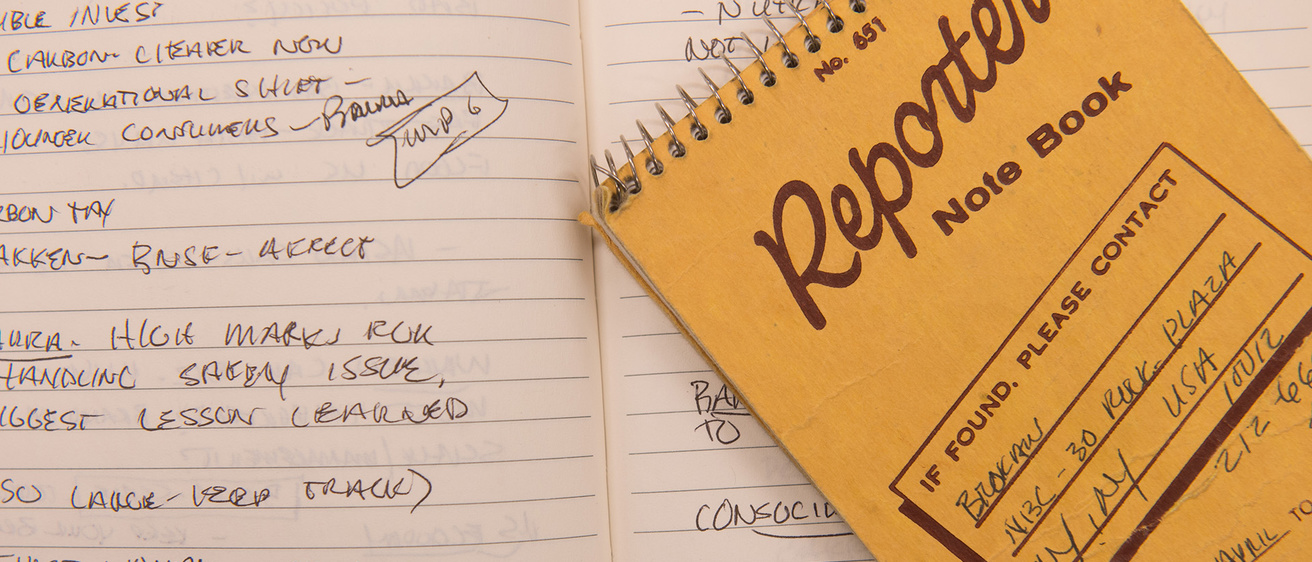Aspiring journalists have numerous reasons for wanting to join the ranks of the profession and its related fields.
Journalists hold those in power accountable and can influence public policy. The profession speaks to people with a love for storytelling. There are many types of journalism to suit your personal interests and ambitions. And the skills of a journalist translate well in several career fields, making a journalism degree a valuable option.
But you know what else drives people? The financial stability to pay the bills. While journalism offers a fascinating and rewarding career path, you might be asking yourself an important question: Is a journalist's salary going to allow me to make a living?
Let’s dive into salary data across journalism professions and U.S. regions, talk a bit about demand in the industry, and examine which positions — whether in traditional journalism or in related communication fields — tend to pay the most.
How much do journalists make?
As you might suspect, putting a dollar amount on a journalist’s salary depends on certain circumstances. Experience, geography, and types of journalism are all variables.
Below you’ll find salary ranges, categorized by the type of job often held by those with a journalism degree. The average annual salary is there, but we also want to show what an income looks like at various percentiles (10th, 25th, 50th, 75th, and 90th). The lower points give you an idea of where entry-level jobs might land or what you might be paid in certain geographic regions that aren’t major media markets. (It’s not impossible to make six figures right out of college, but it’s hardly common.)
| CATEGORY | AVERAGE | 10TH % | 25TH % | 50TH % | 75TH % | 90TH % |
|---|---|---|---|---|---|---|
| Public relations managers | $159,420 | $76,160 | $99,180 | $134,760 | $191,840 | ≥ $239,200 |
| Advertising and promotion managers | $152,620 | $63,580 | $88,810 | $131,870 | $188,530 | ≥ $239,200 |
| Digital communication managers | $146,320 | $67,370 | $97,990 | $133,560 | $174,510 | $225,120 |
| Fundraising managers | $133,620 | $68,800 | $86,880 | $119,200 | $162,660 | $212,730 |
| Web and digital interface designers | $108,820 | $48,210 | $66,020 | $98,540 | $139,500 | $176,490 |
| Producers and directors | $107,170 | $42,040 | $58,540 | $82,510 | $128,040 | $174,540 |
| News analysts, reporters, and journalists | $101,430 | $31,550 | $38,160 | $57,500 | $91,890 | $160,360 |
| Writers and authors | $87,590 | $40,900 | $52,660 | $73,690 | $100,990 | $148,240 |
| Broadcast announcers and radio DJs | $86,950 | $24,400 | $30,920 | $44,890 | $66,070 | $127,560 |
| Technical writers | $86,620 | $48,630 | $62,060 | $80,050 | $102,260 | $129,440 |
| Editors | $85,110 | $38,790 | $51,810 | $75,020 | $101,100 | $138,920 |
| Film and video editors | $83,470 | $38,990 | $48,920 | $66,600 | $101,910 | $154,480 |
| Public relations specialists | $77,720 | $38,570 | $50,280 | $66,750 | $92,290 | $126,220 |
| Fundraisers | $70,760 | $39,440 | $49,560 | $64,160 | $83,120 | $106,700 |
| Health education specialists | $69,790 | $39,630 | $48,210 | $62,860 | $83,800 | $107,920 |
| Photographers | $53,380 | $28,510 | $32,240 | $40,760 | $62,480 | $95,740 |
| Proofreaders and copy markers | $51,100 | $31,730 | $37,940 | $48,790 | $59,090 | $75,510 |
Source: U.S. Bureau of Labor Statistics, May 2023
How much do journalists make in California? In Illinois? Where I live?
The average journalist salary figure does differ by region. A New York Times journalist’s salary likely exceeds what a reporter makes at a smaller paper in a different part of the country. Other regions have greater demand for certain types of journalists — salary data show that, on average, major broadcast media markets pay more-competitive rates, for instance.
Below you’ll find a sampling of average salaries for popular jobs for journalism and mass communication grads, pulled from states located in various regions of the United States.
| CATEGORY | U.S. avg. | California | Arizona | Colorado | Minnesota | Illinois | Georgia | D.C. | Maine |
|---|---|---|---|---|---|---|---|---|---|
| Public relations managers | $159,420 | $170,470 | $115,710 | $156,370 | $147,650 | $134,850 | $152,160 | $224,110 | $127,530 |
| Advertising and promotion managers | $152,620 | $175,080 | $141,080 | n/a | $120,040 | $117,550 | $158,550 | $127,200 | $132,740 |
| Digital communication managers | $146,320 | $181,760 | $139,130 | $168,620 | $154,030 | $143,940 | $128,990 | $168,180 | $116,420 |
| Fundraising managers | $133,620 | $154,200 | n/a | $140,140 | $119,700 | $109,830 | $124,960 | $155,480 | $117,590 |
| Web and digital interface designers | $108,820 | $137,180 | $97,850 | $115,720 | $88,000 | $82,100 | $101,970 | $96,270 | $78,530 |
| Producers and directors | $107,170 | $132,990 | $64,450 | $89,080 | $71,300 | $85,570 | $91,950 | $102,380 | $77,930 |
| News analysts, reporters, and journalists | $101,430 | $130,570 | $57,750 | $66,160 | $47,860 | $52,810 | $83,810 | $138,590 | $51,080 |
| Writers and authors | $87,590 | $108,640 | $62,480 | $90,990 | $73,740 | $69,630 | $96,500 | $105,100 | $101,530 |
| Broadcast announcers and radio DJs | $86,950 | n/a | $57,040 | $95,080 | $45,560 | $65,570 | $60,620 | n/a | $42,800 |
| Technical writers | $86,620 | $109,380 | $58,030 | $93,530 | $78,540 | $88,620 | $82,780 | $102,070 | $74,950 |
| Editors | $85,110 | $103,380 | $70,630 | $76,260 | $61,540 | $69,050 | $66,770 | $106,460 | $62,180 |
| Film and video editors | $83,470 | $101,600 | $60,030 | $70,860 | $64,730 | $59,860 | $54,620 | $83,830 | $46,050 |
| Public relations specialists | $77,720 | $87,770 | $70,290 | $80,620 | $74,320 | $76,570 | $91,040 | $114,250 | $60,830 |
| Fundraisers | $70,760 | $81,430 | $84,750 | $74,350 | $71,380 | $64,760 | $68,710 | $82,950 | $65,620 |
| Health education specialists | $69,790 | $76,460 | $63,410 | $64,470 | $70,740 | $67,000 | $95,140 | $106,100 | $58,400 |
| Photographers | $53,380 | $75,510 | $45,550 | $55,030 | n/a | $44,050 | $55,160 | $88,540 | $48,220 |
| Proofreaders and copy markers | $51,100 | $65,730 | n/a | $48,960 | $48,720 | $47,310 | $42,510 | $83,440 | n/a |
Source: U.S. Bureau of Labor Statistics, May 2023
(If you are interested in numbers from other states, visit the U.S. Bureau of Labor Statistics website and select the state you’re interested in. There’s a lot of data on each state’s page; searching the page for a specific job title is a quick way to find what you want.)
Yes, certain regions have higher salaries. But it would be wise to plug numbers into a cost-of-living calculator to see how far a dollar in one region might stretch (or shrink) in a different ZIP code. There are many calculator options on the web; this one from SmartAsset has a broad selection of U.S. cities available for comparison.
What is the highest-paying job in journalism?
The literal answer to this would involve name-dropping of famous faces. The annual salaries of many well-known broadcasters — including journalism and mass communication grads such as David Muir, Robin Roberts, and Stephen A. Smith — are purported to be large enough to necessitate two commas.
While it’s good to have lofty goals, it might not be best to hold up the highest-paid journalists as the definition of a journalism degree salary.
There are different professions within the various types of journalism to consider, and you might want an answer that looks beyond traditional journalism and encompasses various occupations that can be attained with a journalism degree.
As shown in the chart seen earlier on this page — scroll back up to see the figures — certain positions in digital communication, public relations, and advertising might bump you up a tax bracket, especially at the management level. For example:
- Advertising managers and public relations managers see average salaries a bit north of $150K.
- Digital communication managers are not far behind that mark.
In terms of traditional journalism jobs, the average salary data above point to news analysts/reporters/journalists as the most lucrative job category — but this comes with a caveat. While that category sees an average salary just over $100K, it’s worth noting that the median salary — the dollar amount at which there is an equal number of people earning more and less than that — is $57,500. That would indicate that the top earners in the category are seriously skewing the average salary figure.
Is it hard to get a job as a journalist?
Average salary figures don’t mean a lot to aspiring journalists who can’t find work. So, is your journalism degree going to be worth it? Are there jobs out there?
There is demand for people who hold a journalism degree, both in traditional journalism settings and in fields that crave critical thinkers who can communicate. This is true whether you’re seeking an entry-level journalism job or a seasoned pro looking for your next challenge.
There were hundreds, if not thousands, of postings for jobs in the United States across many types of journalism and related fields, and forecasts from the U.S. Bureau of Labor Statistics through the year 2032 look strong for many disciplines.
Traditional journalism and mass communication jobs, however, are projected to decline over the next few years, anywhere from 3% to 4%. That said, average annual openings certainly won’t run dry. The projected employment growth for digital communication, public relations, advertising, fundraising/development, and most broadcast fields is more positive.
| Job Category | Projected Employment Growth (through 2032) | Average Annual Openings (through 2032) | Job Posts in Past 12 Months |
|---|---|---|---|
| Web and digital interface designers | 12.00% | 10,700 | 11,836 |
| Film and video editors | 9.40% | 5,000 | 3,929 |
| Health education specialists | 7.20% | 6,600 | 3,888 |
| Technical writers | 6.90% | 4,800 | 19,486 |
| Producers and directors | 6.70% | 16,000 | 12,343 |
| Public relations specialists | 6.10% | 25,800 | 87,102 |
| Public relations managers | 5.90% | 5,400 | 20,271 |
| Fundraisers | 5.20% | 9,900 | 11,390 |
| Fundraising managers | 5.10% | 2,500 | 8,458 |
| Photographers | 4.10% | 13,900 | 10,244 |
| Writers and authors | 3.70% | 31,800 | 16,341 |
| Advertising and promotion managers | 1.90% | 2,800 | 719 |
| Digital communication managers | -2.30% | 94,400 | 51,872 |
| News analysts, reporters, and journalists | -3.30% | 25,800 | 10,106 |
| Proofreaders and copy markers | -3.90% | 900 | 584 |
| Editors | -4.00% | 11,600 | 9,652 |
| Broadcast announcers and radio DJs | -11.40% | 2,400 | 1,899 |
(Sources: Job posting data from Chmura/JobsEQ; projected employment growth and average annual openings from U.S. Bureau of Labor Statistics)
OK, so how does one stand out in an applicant pool?
The skills of a journalist fall into two categories: hard skills and soft skills. In terms of hard skills, employers want to know if you can use software and technology specific to the position. Do you know your way around Microsoft Office (or other brands’ equivalents)? Do you understand trends in social media? Are you proficient in audio and/or video editing?
And don’t sleep on soft skills — hiring managers want people with outstanding communication skills, the ability to prioritize/manage their time, people who work well in teams ... and did we mention outstanding communication skills? The ability to communicate is vital to any industry, not just journalism/mass communication.
“The flexibility of a journalism degree and the ability to develop skills that will stay with you even as industries change — that’s incredibly valuable,” says Melissa Tully, director of the School of Journalism and Mass Communication at the University of Iowa. “The journalism degree experience will serve graduates well at their first job, their second job, and the rest of their lives.”
Related content

Are journalism degrees worth it?

What jobs can you get with a journalism degree?

